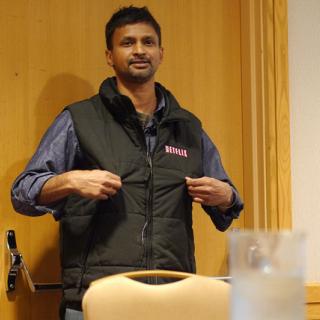Track: Scalable Microservice Architectures
Location:
- Grand Ballroom B/C
Day of week:
- Wednesday
Microservices refer to the practice of decomposing monolithic software applications into a suite of fine-grained and independently manageable services. This practice, coined by Netflix, is being adopted by a growing number of companies. Many pioneers of this architectural pattern deploy hundreds of microservices in the cloud and in private data centers. While microservice architectures improve fault isolation, availability, and development iteration, they do present certain challenges. For example, they do increase operational complexity, impedance mismatch (between interacting services), and versioning complexity. What does it take to effectively manage hundreds of microservices? What tooling is available? How does one architect a web service that has 100s of build-time and run-time dependencies? How fine grained should your microservices be? Should you follow this trend or are monolithic apps better suited for you? Come learn from the pioneering practitioners of this school of philosophy.

by Paul Osman
Director of Platform Engineering at 500px
Microservices are becoming an increasingly popular way to build software systems. Thanks to evangelism from companies like Netflix, Amazon, Gilt, ThoughtWorks and SoundCloud, more organizations are considering whether or not they should adopt this practice.
In this talk, I’ll discuss our experiences evolving 500px from a single, monolithic Ruby on Rails application to a series of composable microservices written in Ruby and Go. I’ll talk about the challenges we faced from a business,...
by Chris Richardson
Java Champion and Author of POJOs in Action
In this talk we share our experiences developing and deploying a microservices-based application. You will learn about the distributed data management challenges that arise in a microservices architecture.
We will describe how we solved them using event sourcing to reliably publish events that drive eventually consistent workflows and update CQRS-based views.
You will also learn how we build and deploy the application using a Jenkins-based deployment...
by Richard Kasperowski
QCon Open Space Facilitator
Open Space
Join Sudhir Tonse, our speakers, and other attendees as we explore microservices. Many pioneers of this architectural pattern deploy hundreds of microservices in the cloud and in private data centers. While microservice architectures improve fault isolation, availability, and development iteration, they do present certain challenges. For example, they do increase operational complexity, impedance mismatch (between interacting services), and versioning complexity. What does it take to...
by Sudhir Tonse
Responsible for Netflix Cloud Platform
Netflix morphed from a private datacenter based monolithic application into a cloud based Microservices architecture. This talk highlights the pros and cons of building software applications as suites of independently deployable services, as well as practical approaches for overcoming challenges - especially in the context of an elastic but ephemeral cloud ecosystem. What were the lessons learned while building and managing these services? What are the best practices and anti-patterns?
...by Steven Ihde
Director of Service and Presentation Infrastructure at LinkedIn
by Karan Parikh
Software Engineer at LinkedIn
LinkedIn's evolution from a monolithic application to a microservice-based architecture has been years in the making and is still ongoing. As we scaled in terms of site traffic and the number of engineers, decomposition has been a key driver of our architecture. Decomposing not only the release vehicle but also the codebase and finally decentralizing control of the development and release process has enabled us to evolve our system more rapidly.
One of the key components in LinkedIn's...
by Shobana Radhakrishnan
Vice President of Engineering at Mindflash
Mindflash exposes API services to over a 1000 corporate customers and also integrates with several third-party services such as Zuora, Salesforce, KISSMetrics, Yammer to name a few.
In this talk, I will share details about best practices we adopted in implementing these API integrations with a lean startup like Mindflash, and also share some examples of how we manage changes related to services, and enable our systems to recover quickly and gracefully in case of failures.
I...
Tracks
Covering innovative topics
Monday, 3 November
-
Architectures You've Always Wondered about
The newest and biggest Internet architectures
-
Real World Functional
Putting functional programming concepts to work in the real world.
-
The Future of Mobile
The future of mobile and performance improvements
-
Continuous Delivery: From Heroics to Becoming Invisible
Continuous Delivery philosophies, cultures, hiccups, and best practices.
-
Unleashing the Power of Streaming Data
This track explores a variety of use-cases, platforms, and techniques for processing and analyzing stream data from the companies deploying them at scale!
-
Sponsored Solutions Track I
Tuesday, 4 November
-
Engineering for Product Success
Architectures that make products more successful
-
Reactive Service Architecture
Reactive, Responsive, Fault Tolerant and More.
-
Modern CS In the Real World
How modern CS tackles problems in the real world.
-
Applied Machine Learning and Data Science
Understand your big big data!
-
Deploying at Scale
Containerizing Applications, Discovering Services, and Deploying to the Grid.
-
Sponsored Solutions Track II
Wednesday, 5 November
-
Beyond Hadoop
Emerging Big Data Frameworks and Technology
-
Scalable Microservice Architectures
This track addresses the ways companies with hundreds of fine-grained web-services (e.g. Netflix, LinkedIn) manage complexity!
-
Java at the Cutting Edge
The latest and greatest in the Java ecosystem
-
Engineering culture
Successes and failures in creating an engineering culture.
-
Next gen HTML5 and JS
How Web Components, the Future of CSS, and more are changing the web.
-
Sponsored Solutions Track III


